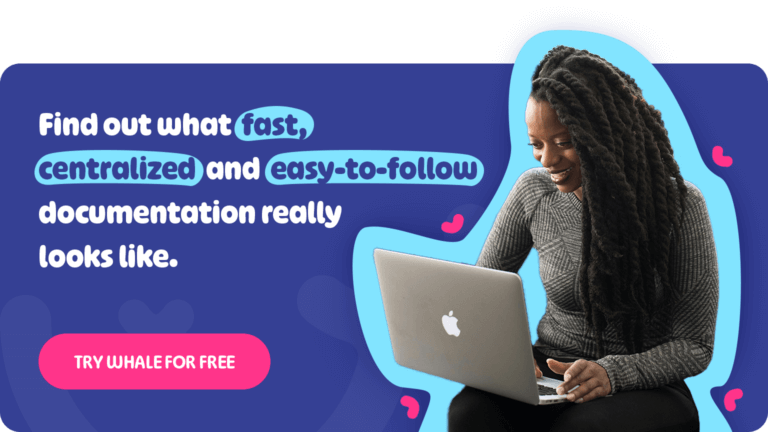If you don’t have an employee training program in your business, this is for you.
Skills sets for jobs have changed by around 25% since 2015. By 2027, this number is expected to double.
How to build an employee training program?
While every training program will look different, there are some fundamental basics to creating one that you should know.
Let’s cover the basics of how to build one.
1. Conduct an assessment
There are two essentials to understand before you start working on your training program.
- Where does the business need to go?
- Where are your employees currently?
That’s why it’s best to start with assessing your current approach. Where in your business is there low productivity? What are the essential skills needed for the next year? Are there any noticeable skill gaps? Are these gaps seen only in new hires or your employees with long tenures, too?
The second part of your assessment would be to talk to your employees. After all, you can’t create a program that boosts productivity levels if you don’t know what’s hindering them.
Conduct an anonymous survey and ask team members:
- What skills do they currently have?
- What skills are they missing that can help them be more productive at their job?
- What skills do they need to develop more?
Not only can this information help you create your training program, but it can also help you customize it to your employees’ needs so no part is wasted.
2. Set your training goals
Once you know where your employees stand, it’s time to set your goals. If your employees have varying knowledge and skill needs, consider creating multiple learner personas or tackling them in separate programs.
You’ll also take the time to align your training and business goals. Surprisingly, the two aren’t mutually exclusive. There are other benefits of employee training, like increasing customer satisfaction.
So, at the end of this program, what goal are you trying to accomplish that impacts employees and your business? Increased productivity? Happier customers?
You’ll always know what you expect from this program if you write down your goals.
When considering employee training program goals, consider things like;
- How will employee performance improve after the program?
- How will the program improve employee retention?
- How will ROI be measured?
3. Determine the best training method for your employees
Determining the right type of training program for your team member is all about understanding what skills your team members need to develop and what will work best given their specific needs.
You can determine this by developing a training matrix that will ensure that you’re providing team members with training that provides them and the business with growth.
Once you’ve discovered the perfect type of training, you can decide if training should be delivered remotely (online), in person or a combination of all of the above.
Remember, however, that no matter how effective the training is, learners, on average, will forget 50% of what they learned within an hour.
So ensure you have a strategy and the right tools to help learners access and retain knowledge.
4. Create a plan
Your plan is where you document everything you and your employees will need for this program to succeed. For an instructor-led program, you’ll need to hire an expert. Or, if your training program is for new employee onboarding, your plan might include video lessons and simulations.
Regardless of how your program looks, your plan will need to answer:
- ✅ Who is this for?
- ✅ What topics will be covered? I.e. What will they learn?
- ✅ How will training be delivered?
- ✅ Who will create the content?
- ✅ What’s the timeline?
- ✅ What’s the goal? (p.s. You just worked on this.)
- ✅ What resources will we need?
- ✅ How will we measure results?
- ✅ What’s our budget?
- ✅ How will we collect feedback on the program?
With employee training software like Whale, you can deliver an employee training program that delivers.
5. Invest in the necessary training resources and content
What resources are you going to need to develop an effective employee training program?
The answer to this will depend on what type of training you aim to deliver. Irrespective of whether you send your team members on external training or whether you deliver in-house, or a blend, that you use an employee onboarding and training tool.
In terms of resources, consider budget, tools, content, and time.
6. Create content that delivers
With your high-level work training plan in hand, it’s time to build the training content.
Creating content that team members love can be easy! Use engaging images, videos and even emojis 😜 to make it fun.
Ideally, you should consolidate all this training material in a centralized location for effortless access, both during and after the training sessions.
7. Deliver training, measure and update as needed
Drum roll, please 🥁 — it’s time to put your program into action!
Create training flows, use quizzes to assess results and most importantly measure to see how the plan is delivering on the objectives first set out.
Measuring your training’s effectiveness might seem like a no-brainer. But most companies don’t do it. Only about 50% of companies bother tracking what their employees have to say about the training.
Talk to your managers and see if they noticed any short- or long-term improvements. If the results were only short-term, you might need to change your program to fight the forgetting curve, which is typical in employee training.
💡 Don’t forget to get feedback employees too!
Did they find it engaging? Has it added value in their role? What could be done better? Measuring your training programs helps ensure you maximize your program’s chance of success.
9 Types of employee training programs
Finding the best employee training program for your team is going to depend on their needs and that of the business. Ideally, you’ll already have defined this in your product training matrix.
1. Onboarding training
Remember your first day at a new job? It can be overwhelming. Onboarding training is all about helping new hires get comfortable with the company culture, policies, and their specific roles. Think of it as a warm welcome and a friendly guide.
Onboarding training is designed to get a new hire fully up to speed and ready to start their new role in confidence.
2. Orientation training
Orientation training can be similar to onboarding training; however, it’s generally more practical and shorter in duration.
Some companies combine both together when onboarding new hires.
Orientation training provides basic organizational information that new hires need and can include everything from;
- Safety training to
- meeting schedules to
- introduction to the organization chart and
- workplace tools, systems, supplies, and equipment.
And yes, even where the coffee machine is.
3. Compliance training
Nobody wants to get caught in a legal or regulatory bind. Compliance training ensures your team knows the rules and regulations they must follow. It’s especially crucial in industries like finance and healthcare, where there’s no room for error.
Examples include;
- Diversity training
- Paid-time off policies
- Anti-harassment policies
4. Soft skills training
Ever had a miscommunication at work? Soft skills training covers those essential interpersonal skills like communication, teamwork, and problem-solving. It’s about making sure everyone can work well together and tackle challenges effectively.
5. Technical training
Technical training provides employees with the skills needed to perform specific tasks or use particular technologies. This can include software training, machinery operation, and other job-specific technical skills such as legal training, SEO, or any other specific skill.
6. Product training
If your team is selling or supporting your products, they need to know them inside and out. Product training helps them understand all the features and benefits so they can better assist your customers. It’s like turning them into product experts.
We offer product training at Whale to both employees and customers.
7. Leadership training
Got future leaders in your ranks? You won’t know unless you develop them.
Leadership training is designed to develop the skills needed for managerial and executive roles. It covers everything from strategic planning to team management, preparing them for bigger responsibilities.
8. Ongoing training
Ongoing employee training is continuous training that is designed to ensure that employees stay up-to-date and empowered with the skills they need to perform at their best.
9. Transitional training
Transitional training is designed to help team members transition from one role to another.
We often need support to transition to a different role or a different part of the business. This training assists with both adopting new technical skills as well as adopting to a new way of working.
What is the link between employee training programs and business impact?
Training isn’t just about ticking a box – it has a real impact on business performance. According to the Association for Talent Development (ATD), companies with comprehensive training programs enjoy 218% higher income per employee than those without. Plus, they see a 24% higher profit margin.
To see impact from your training programs, make sure you;
1. Calculate Return on Investment (ROI)
Training costs money, but it’s an investment. Calculate the ROI by comparing training costs to benefits like increased productivity and reduced turnover. Look at metrics like sales, error rates, and customer satisfaction.
2. Align Training with Business Goals
Make sure your training programs align with your company’s strategic objectives. This shows how training contributes to achieving those goals and makes it easier to justify the investment.
3. Leverage Technology
Use technology to deliver training efficiently and cost-effectively. Learning platforms (like Whale), virtual classrooms, and mobile training apps offer flexible learning options and can save money in the long run.
4. Encourage a Learning Culture
Create a culture that values continuous learning. Encourage employees to take ownership of their professional growth and provide opportunities for ongoing education and skill development. This keeps everyone engaged and constantly improving.
What are the best examples of employee training programs?
1. McDonald's Hamburger University
Yes, it’s a real thing. McDonald’s Hamburger University trains employees in restaurant management and operations. With campuses worldwide, it offers a blend of classroom instruction and hands-on experience. It’s a gold standard in comprehensive training.
It’s all part of their efforts to systemize training.
2. Google's Googler-to-Googler Program
Google’s Googler-to-Googler (g2g) program is a peer-to-peer training initiative. Employees teach and learn from each other on a wide range of topics, fostering a culture of continuous learning. It’s a win-win for everyone involved.
Common mistakes to avoid when building your training program
Knowing how to build a program that works also requires knowing what mistakes to watch out for.
Watch out for these common mistakes.
Not documenting your training processes
Do you know what’s worse than documenting a training program from scratch? Needing to document the same material and processes again because you didn’t store that information somewhere.
Not our definition of a good time. 😩
Not only can this process feel tedious, but it’s time-consuming and can take away from building and adding to your programs. Instead, use an employee training tool like Whale that helps you document your processes and training material in one place.
Not choosing the best method for your team
There isn’t a hard and fast rule for the training methods you should choose. However, choosing a method that doesn’t align with your team and goals can hurt your program’s success rate. So, take some time to go over the information you gathered to decide which method can give you a great ROI.
Cramming too much information into one program
A common issue businesses face is throwing everything into a training program. It can be tempting to want to fix the areas your teams aren’t strong in all at once. But it can easily backfire.
Many employee training programs suffer from low course completion rates because the courses are overly lengthy. It can be challenging for employees to dedicate an hour or more of their already busy day to training sessions.
One effective solution to address this issue is microlearning, which offers short and concise learning experiences that require no more than 10 minutes to finish. These microlearning modules present information in smaller, easily digestible portions, contrasting with conventional e-learning courses that can take hours or even days to complete.
Research has demonstrated that microlearning results in higher knowledge retention compared to traditional e-learning methods.
💡 PS You can do this easily on Whale using automated training flows.
Bottom line?
While success is in the eye of the beholder, it also has tangible benefits, like the companies that train their employees experience. Luckily, by following our step-by-step guide on building your training program and watching out for those common mistakes, you’ll be reaping the benefits in no time!
Ready to start training your employees but need somewhere to house all your training documents? Then try Whale for free today — our tool lets you organize your training documents and train your team!
FAQs about employee training programs
What’s the best way to measure the effectiveness of a training program?
It’s best to measure training effectiveness through a mix of assessments, feedback surveys, and performance metrics. Look at KPIs like productivity, error rates, and retention to see how well the training is working.
Can small businesses afford comprehensive training programs?
Absolutely! Small businesses can use cost-effective solutions like online learning platforms and peer-to-peer training to scale their learning. Investing in training pays off in the long run with a more skilled and motivated workforce.








